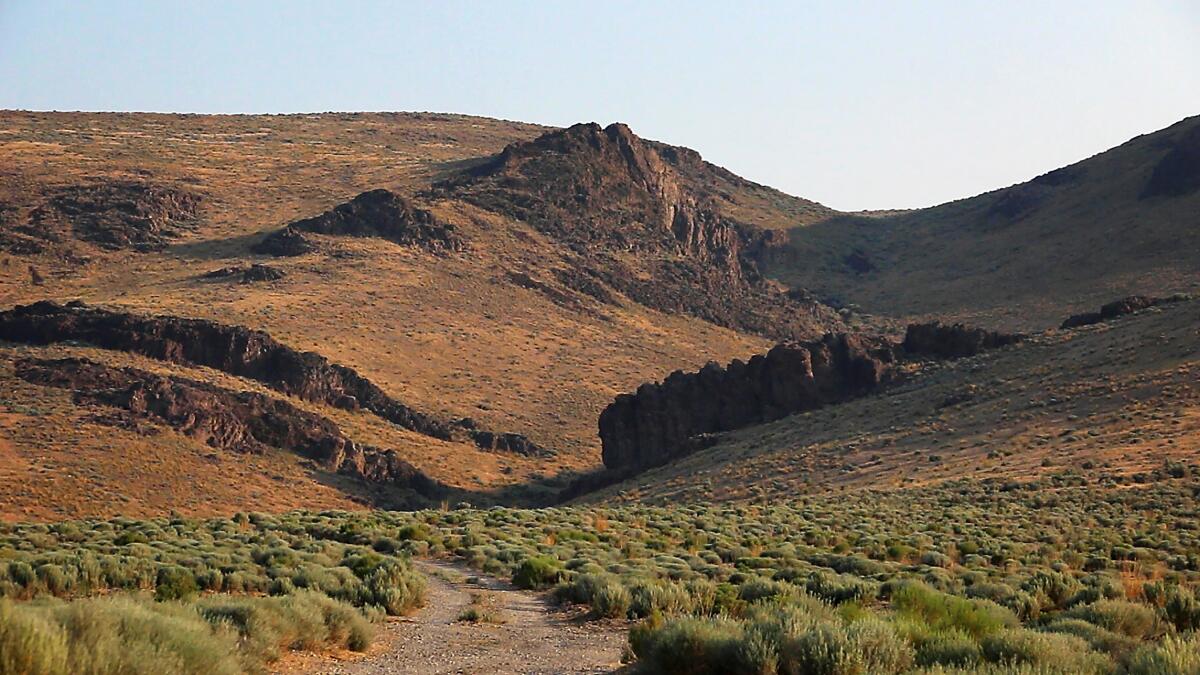Court fights raise caution flags on green energy push in Nevada

- Share via
RENO — Opposition from friends, not foes, is creating potential roadblocks to President Biden’s green energy agenda on federal lands in the blue-leaning, Western swing state of Nevada.
Two lithium mines and a geothermal power plant in the works in the biggest U.S. gold-mining state are under attack from conservationists, tribes and others who otherwise generally support Biden’s efforts to expedite the transition from fossil fuels to renewables.
The conflicts put a spotlight on an emerging reality as the Biden administration tries to meet its goal of having the U.S. power grid run on clean energy by 2035.
Renewable or not, the actual mining of the resources faces many of the same regulatory and environmental hurdles the government has encountered for decades when digging for coal or drilling for oil.
Whether it’s tapping hot underground water to generate electricity with steam-powered turbines or extracting lithium to make electric car batteries, the operations still must comply with laws designed to protect wildlife habitat, cultural and historical values, and guard against pollution or other degradation of federal lands.
During a recent failed attempt to overturn a Nevada water permit for a mine near the Oregon line above the biggest known lithium deposit in the nation, opponents raised some of the same concerns leveled four decades ago about some of the largest gold mines in the world.
Specifically, the Great Basin Resource Watch and others say the lithium mine will produce toxic waste. More generally, they still accuse regulators of rubber-stamping industry plans without a thorough review of the potential harms.
“Everything seems to be in the hands of the mining company,” Sarah Wochele, a mining justice organizer for the Progressive Leadership Alliance of Nevada, said at last month’s appeal hearing. “And we just ignorantly praise new technology, new technology.”
In Ukraine, new Western-supplied weaponry is generating some battlefield success. But victory boasts can undercut continuing appeals for arms.
Ramped up domestic production of lithium is key to Biden’s blueprint for a greener future, a critical element for electric vehicle batteries. Worldwide demand for the lightest metal on Earth is projected to increase six-fold by 2030 compared with 2020.
The big deposit bordering Oregon where Lithium Nevada plans to begin construction in December is “vital to our national security and nation’s need for lithium to support green energy development and achieve climate change objectives,” the company said in recent court filings.
But in addition to concerns about toxic waste, the mine sits on federal land local tribes say is a sacred site where dozens of their ancestors were massacred by the U.S. Cavalry in 1865.
Another big lithium mine still on the drawing board, halfway between Reno and Las Vegas, is home to a rare desert wildflower the U.S. Fish and Wildlife Service has proposed for listing under the Endangered Species Act.
Meanwhile, the geothermal power plant faces cultural and environmental challenges in a case pending before the 9th U.S. Circuit Court of Appeals.
The San Francisco-based appellate court could rule any day on a lawsuit seeking to halt the development in a high-desert oasis 100 miles east of Reno where a rare toad currently protected under the Endangered Species Act lives in the same hot springs where Native Americans have worshipped for thousands of years.
The Interior Department’s Bureau of Land Management approved Ormat Nevada’s geothermal project in November over the objections of another Interior agency, the U.S. Fish and Wildlife Service.
Since then, the Fish and Wildlife agency has taken the rare step of declaring the Dixie Valley toad endangered on a temporary emergency basis — something it’s done only one other time in 20 years.
This month, the Center for Biological Diversity and the Fallon Paiute-Shoshone Tribe amended their lawsuit against the Reno-based Ormat and the Bureau of Land Management in U.S. District Court in Reno to include the April listing.
The updated version alleges both are in violation of the Endangered Species Act because they’ve failed to halt construction “despite USFWS’s unambiguous finding that the project poses an imminent and existential risk to the Dixie Valley toad.”
The government hasn’t responded yet, but the case continues in district court on a parallel track with the appellate court. And the ongoing legal battles underscore the difficulty of turning Biden’s vision of a cleaner energy future into reality.
Administration officials insist they’ve known all along that implementing their plans to slow the warming of the Earth wouldn’t be easy.
“Catalyzing the clean energy economy and seeing renewable energy projects through to completion is no small task,” said Tyler Cherry, press secretary for Interior Secretary Deb Haaland.
“Indeed, these are complex, large-scale projects that require a robust public process,” he wrote in an email July 12 to the AP in response to a request for comment.
The three-judge panel at the 9th Circuit that heard oral arguments on the geothermal case in June said they couldn’t consider the April listing of the toad because it came after the appeal was filed in January.
But the judges acknowledged the U.S. Fish and Wildlife Service had raised similar objections in earlier opinions, warning about the likelihood the geothermal plant’s operations could push the toad to the brink of extinction.
The Justice Department lawyer representing the bureau, Michelle Melton, said federal law required the bureau to consider the Fish and Wildlife agency’s criticisms but it wasn’t bound by them.
The emergency listing of the toad doesn’t change the bureau’s position that the project will have no significant effect on the tribe or the toad, she said.
“Fish and Wildlife has a different opinion,” Melton said. “It was not a surprise to BLM that Fish and Wildlife felt that way.”
Ormat Vice President Paul Thomsen said the emergency listing overstates the potential impact of the project on the toad partly because it makes false assumptions about underground faults in the geothermal reservoir it intends to tap.
“There are sufficient safeguards in place to avoid endangering the toad,” he wrote June 6 in comments to the U.S. Fish and Wildlife Service.
The 9th Circuit judges appeared sympathetic last month to some of the opponents’ arguments. But they noted that the lower court judge had weighed the pros and cons and determined the public was best served by allowing the temporary injunction blocking construction to expire 90 days after it was issued in February.
They pointed to Judge Robert C. Jones’ conclusion that the electricity produced at the geothermal plant would significantly reduce greenhouse gas emissions compared with other energy production facilities and that “depriving the public of a source of carbon-free” electricity is not in the public’s best interest.
Scott Lake, a lawyer for the Center for Biological Diversity, said the benefits of renewable energy resources are “something the tribe and the center actually agree with.”
“But nothing in the record establishes a public interest in, or a compelling need, for this particular project ... on a tribal sacred site and in such a way that threatens the entire existence of the Dixie Valley toad,” he said.
More to Read
Sign up for Essential California
The most important California stories and recommendations in your inbox every morning.
You may occasionally receive promotional content from the Los Angeles Times.











